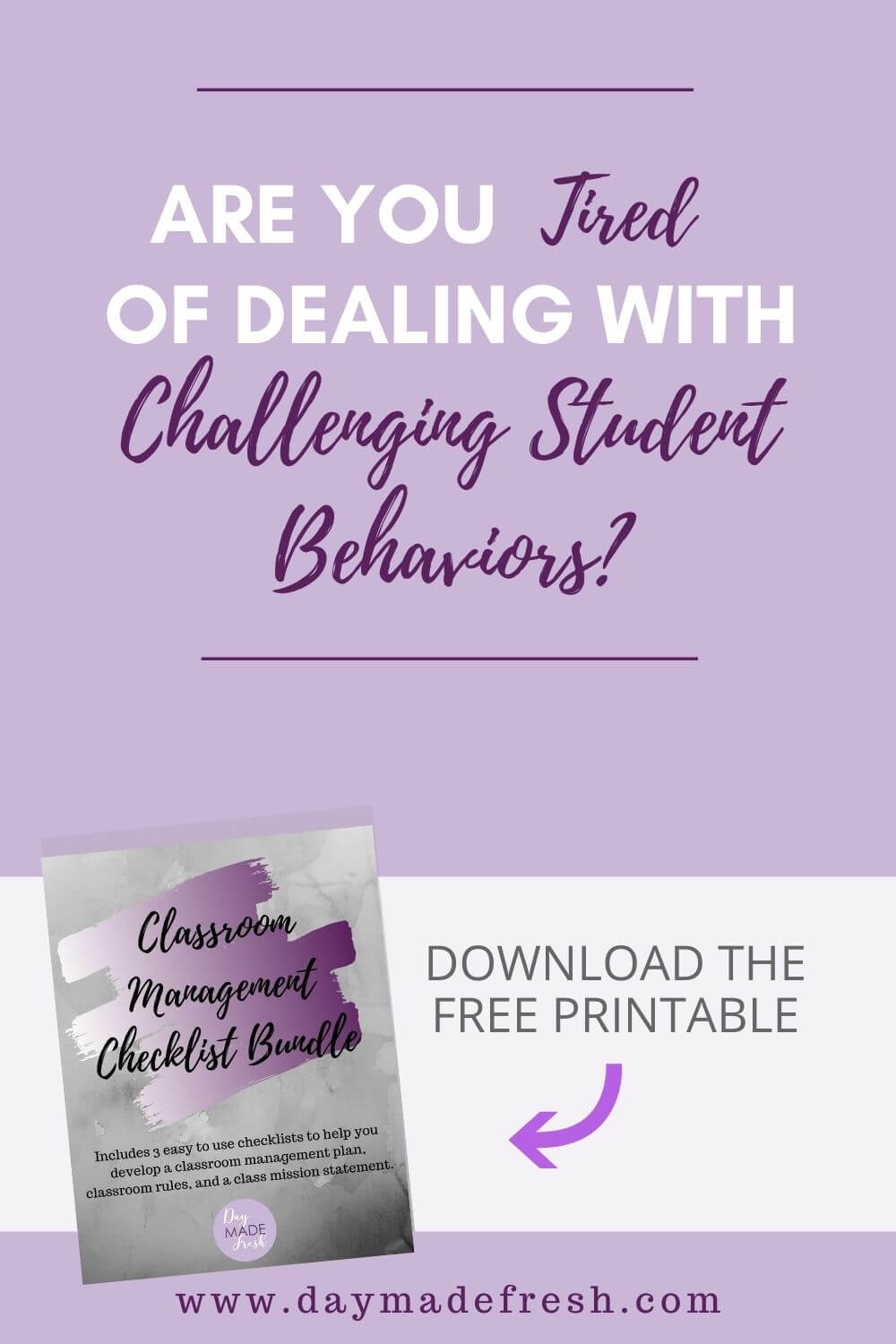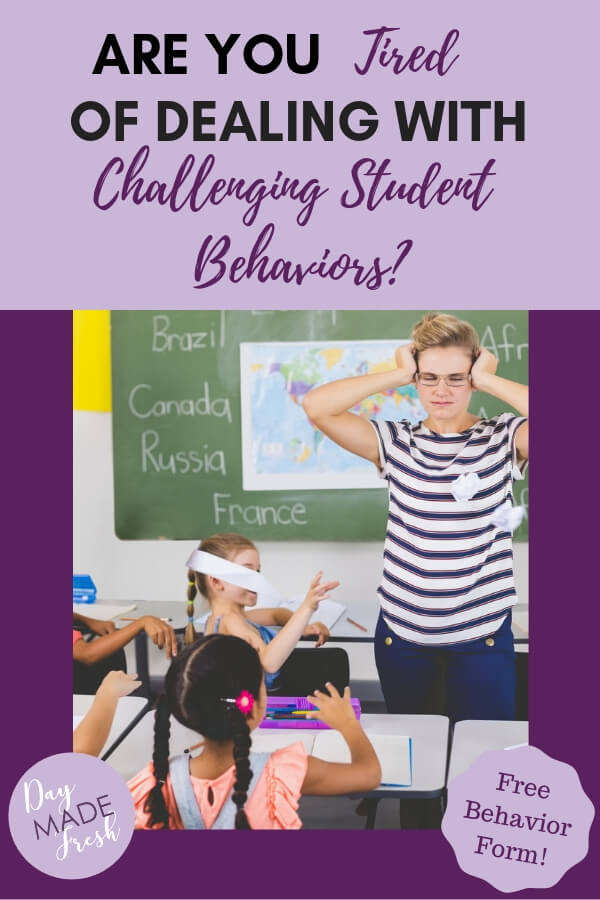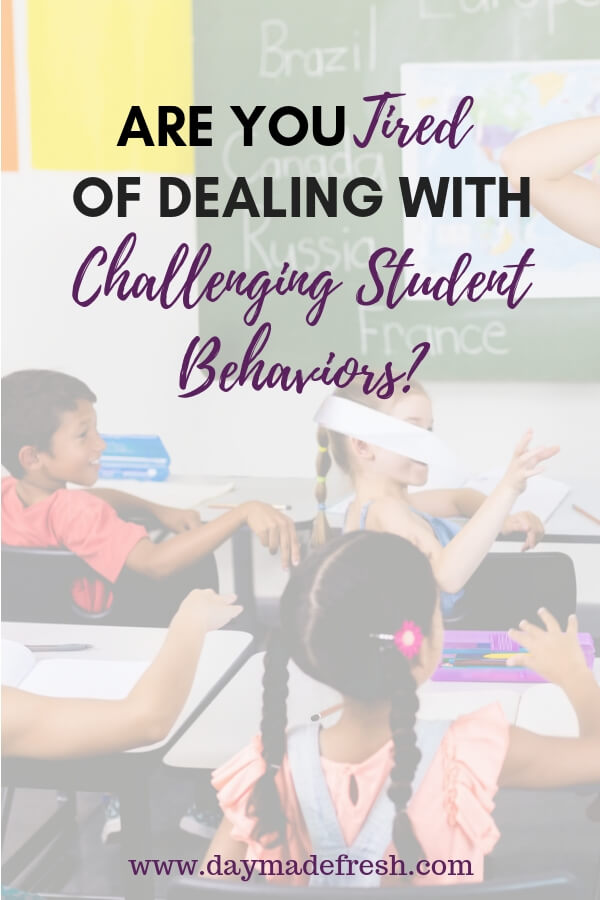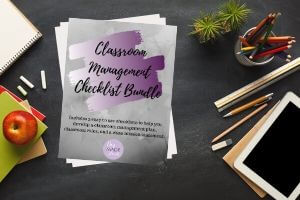Are you ready to pull your hair out because of challenging student behaviors? Have you thought about quitting, because it feels like it is impossible to deal with your toughest students? One challenging student can make a huge impact on an entire class. If you’re faced with more than one, which is the case for many teachers, it feels overwhelming and unfeasible to deal with. When dealing with challenging student behaviors the goal is to encourage the student behaviors you want and discourage the behaviors you don’t want in your classroom. Seems easy enough, but many of the traditional models of dealing with negative behaviors don’t work with challenging students.
I’ve been there, I know how it feels to deal with student behaviors that are a constant detriment to your ability to teach and your students’ ability to learn. A few years ago, I stood in my classroom with chaos all around me. Every chair, desk, and table were flipped over; the carpet was strewn with math manipulatives, ripped papers, notebooks, textbooks, and more making it impossible to not step on something; posters, anchor charts, our class calendar, and student work were torn off the walls; and two students were running around the room yelling at myself and the other adults that had come to help. The rest of the students had been sent to another classroom to keep them safe while we waited for the two students’ parents to arrive.
Sadly, this was not an isolated incident in our class or even the school. We serve a high needs population and many of the students struggle to deal with frustration, anger, and other emotions in a positive way. I had to quickly learn and constantly adapt how I managed my classroom and student behaviors to meet the needs of my students. I’ve field-tested a variety of strategies and I want to share with you the ones that worked and the ones that didn’t. I hope that the strategies below can help you make your classroom a safer and more positive learning and teaching environment.
This post contains some affiliate links for your convenience. Click here to read my full disclosure policy.
You have the power to encourage the student behaviors you want in your classroom.
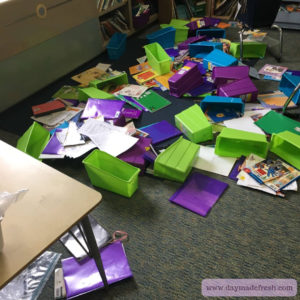
If you want to have an impact on students’ behaviors there are a few mindsets that need to be present. First, kids do not want to be perceived as “bad” or “naughty.” Second, students’ behaviors are not a personal attack towards you.
With those mindsets in place, teachers can work to replace negative behaviors with positive behaviors and new skills by starting small, keeping it simple and introducing balanced rewards. (The goal is to decrease your stress not increase it!)
Kids Don’t Want to Be Bad
When I first started teaching I had the mindset of if a kid does not follow the rules they should have a consequence. This doesn’t sound like an unreasonable mindset, but I’ve learned that there are some faults with this mindset. It implies that students either want to behave or do not want to behave.


Over the years, I’ve shifted to the mindset of kids will behave if they can. One resource that helped me with this mindset shift was the book Lost at School, by Ross W. Greene, PH, D. He includes a whole chapter called “Kids Do Well if They Can” about how other mindsets hinder the process of helping students with behavior challenges. The idea is that kids either have the skills to behave or they are missing skills. So, instead of saying things like, “He’s just not motivated” or “She always wants her own way.” We have to assess what skills a child is missing or as Dr. Ross writes in his book Lost at School:
“If you identify the skills a kid is lacking, you’ll understand why he’s challenging. You’ll also know which skills the kid needs to learn, and you’ll be better equipped to anticipate the situations in which his challenging behavior is most likely to occur.”
Once you have this mindset you can use the process laid out in Lost at School or another resource such as restorative justice (check out this Edutopia article for more information about restorative justice in schools) to help your students learn the skills they need to be successful in the school setting. Kids want to be good, but not all kids come to school with all the skills or tools they need to be successful.
Q-TIP: Quit Taking It Personally
Another mindset teachers should have is that student behaviors are not a personal attack against you. It often feels this way when their behavior affects you personally; such as, when they destroy materials you bought with your own money or when they shout mean, hurtful things at you. However, if we take it personally we will often only see the child in a negative light and not be able to see and identify the skills they need to learn.
If we want to encourage the student behaviors we want in our classrooms we have to put our personal feelings aside and focus on what skills a child needs to learn and then help them learn and develop these new skills so they can flourish in the school setting instead of displaying challenging behaviors when they cannot cope.
The suggestion to not take student behaviors personally is easy to give, but it can be hard to put into practice when you are dealing with a challenging student or students on a daily basis. I got the Q-TIP acronym from a professional development during my first year of teaching. The presenter passed out a Q-TIPs to each teacher as a visible reminder of this mindset. Use this reminder or another one to help you remember this even when you’re feeling overwhelmed and defeated when dealing with a student.
Replace Challenging Student Behaviors by Teaching New Skills
As I’m sure you’ve noticed the first two parts of this post are about changing the teacher’s mindset, not the student’s. Now is when we start working to change the student’s behavior by replacing challenging behaviors with the desired behavior by teaching new skills. We have to focus on ourselves as teachers first before we can begin to truly help our students become successful in the school setting and hopefully beyond.
I often went to one of our special education teachers for advice when I was struggling with challenging student behaviors. In the beginning, I was looking for her to give me great ideas for logical consequences for student behaviors. She quickly made it clear that she had a different mindset when it came to dealing with challenging behaviors.
She asked me, “If a student doesn’t know how to do a math problem what do you do?” I replied, “I help them learn how to do it by showing them how to do different strategies.” She followed up with, “So, shouldn’t we teach a student how to behave if they don’t know how?” She was telling me the same thing I ended up reading about in Lost at School.
Once I took a step back I started to look back at my interactions with students and realized that negative consequences or punishments rarely changed a student’s behavior. I realized that if I really wanted to change what was happening in my classroom I would have to help them learn the skills they need, so we could replace the challenging behaviors with more appropriate ones. (Yep, another teacher mindset shift) 🙂
Looking to create a concrete plan for dealing with challenging student behaviors? Click here to get a FREE download of classroom management checklists!!
For example, I had a student that would become physically aggressive when he felt he wasn’t successful or when he worried he wouldn’t be successful on a task. So, I worked with him to develop a plan for when he felt this way. We brainstormed ideas of what he could do instead of hurting others or being unsafe with the furniture in the classroom.
It took some time, but he decided that he could go to our behavior coach’s office to cool down. This wouldn’t have been my first choice; however, he felt ownership of his plan which made him more likely to use it. We made a little, laminated card he could hand me when he needed to cool down and we practiced using it.
It didn’t work perfectly every time, but in the end, we replaced the physically aggressive behavior with another way to handle his frustration that he could apply to other situations as well. One day he got very upset with another classmate. Instead of hurting the classmate he marched up to me with the card and left the room.
The process I did with this student was informal, but in Lost at School, Dr. Ross Greene has a more formal process that would help you develop a plan alongside a challenging student to help them learn the skills they need and to eventually replace the negative behaviors with more positive ones.
Start Small
When trying to replace challenging student behaviors start small. You and the student will become overwhelmed and frustrated if you focus on too many behaviors at one time. For younger elementary students, I would suggest focusing on one skill or behavior at a time and then slowly adding skills or behaviors as previous ones are mastered. I would never go over three behaviors at a time.
Another way to start small is to, at the beginning, acknowledge or reward the student for being successful with the behavior or skill frequently. First, identify how frequently the challenging behavior is happening and when it is happening. Then use this data to plan out times to check in with the child to acknowledge the new skill or desired behavior they are working on.
One strategy is to have a check sheet that you can record when the child is successful with the new skill or behavior. For example, if a student is hitting or bothering peers by put his or her hands on them multiple times a day, but specifically during unstructured times such as gym, recess, and lunch. Then check in with the student before these activities and remind them that they are to keep their hands to themselves at all times. After the activity check in again with the student and mark on the check sheet if they were successful or unsuccessful.
Related: Develop Missing Behavior Skills with Student Behavior Check Sheets
The check sheet can be used as a data source to see if the new skill or behavior is successful. The check sheet can also have rewards attached to it if desired. For instance, if the child is successful five times during the day or meets their goal all morning then they could receive a reward.
Want to try student check sheets with your students? Get a free copy of Student Check Sheets by clicking here!
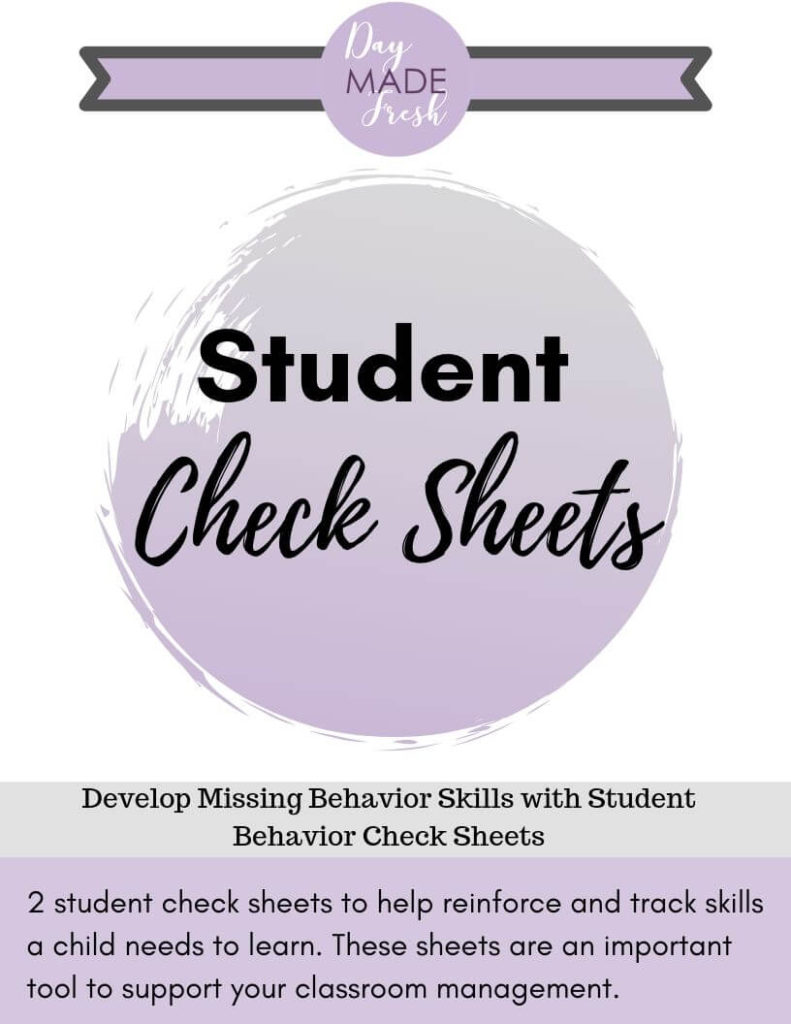
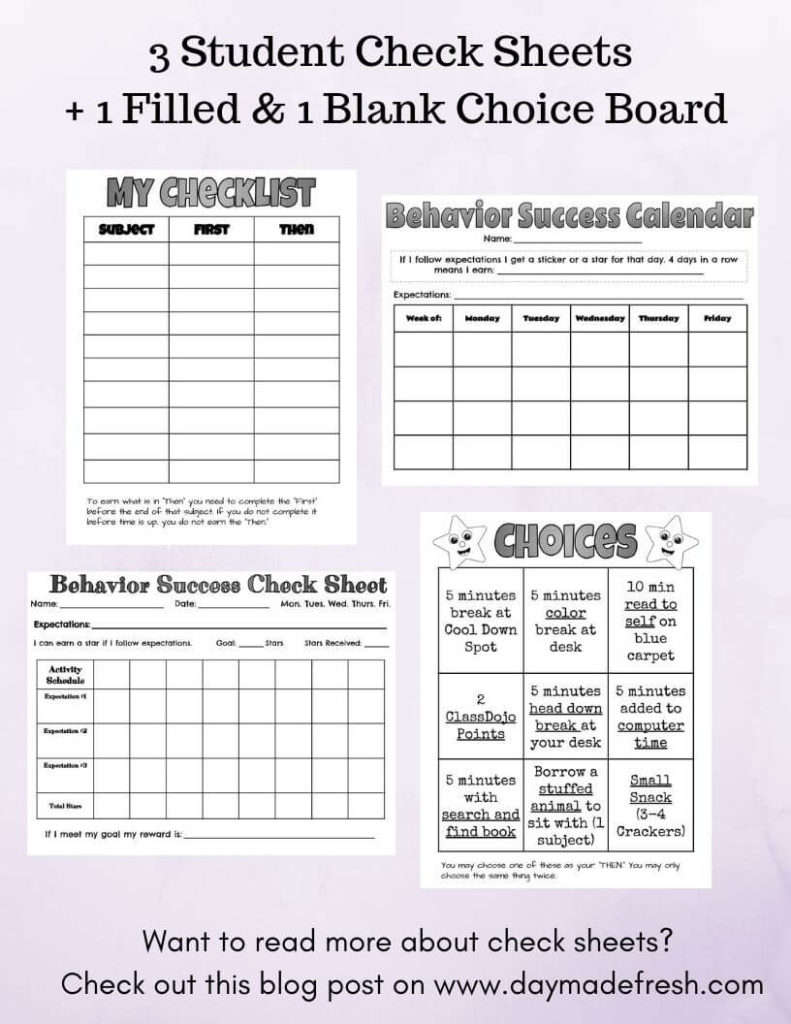
Keep It Simple
To encourage behaviors many of us first think of what prizes or things can my students earn if they are behaving appropriately. There are classroom economy systems, where students earn and lose money based on their choices. Then students spend their classroom currency on rewards, breaks, prizes, etc. If you are currently using a program like this and it works for you…great!

I personally found that while it did have some positive impacts (teaching responsibility, saving, money, etc.) it just took too much instructional time and put too much importance on the rewards versus the desired behaviors.
I have also used a clip chart system where students clip up or down based on their choices during the day. Then at the end of the day, students recorded the color they were on. They would then earn rewards based on the number of “good” days they had. I loved this system at first because it was easy for me to track behaviors and communicate them to parents.
However, I soon discovered that for challenging students this is often asking for an increase in challenging behaviors. Clip charts work great for students that have the skills needed to behave appropriately for school. They rarely had a positive impact on my challenging students and I ended up having to create a personalized behavior plan. (Which did not keep it simple)
My suggestion would be to take the time to evaluate any program you would like to use and see if it includes these components:
- Keeps the focus on the positive.
- Kids have the chance to come back from a challenging moment.
- Helps communicate a child’s day to parents.
- Is simple to implement.
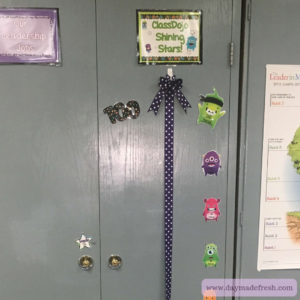
I am currently using ClassDojo which is a free program and easy to set up and use. I use it not only to encourage behaviors, but it also helps me track behaviors, communicate with parents, and document our classroom happenings (Don’t you love multi-purpose programs!). I found that it helps me give more specific praise and corrections. As students earn positive points I specify why they are earning the point. This, in turn, encourages other students to do the same wanted behavior, so they could potentially earn points. Students can also lose points for behaviors that they need to work on. I caution to be careful with the negative or needs work points feature and to try and keep the ratio of positives to negatives at 5:1.
I have used a variety of rewards along with ClassDojo, but I am currently rewarding students that earn 200 points or more on ClassDojo with either a prize from the treasure box or a coupon for a reward or break.
One year, I didn’t use any reward system along with ClassDojo, because the class was motivated enough by earning points. I usually don’t add rewards until October, so I can read the group of kids. Keep your rewards in your back pocket in case you need them, but hold out and wait to see if your students need it.
Keep your system and rewards simple, because your goal is to make things easier by replacing challenging student behaviors. So, don’t make your life more difficult with a complicated or expensive system or rewards.
Looking to create a concrete plan for dealing with challenging student behaviors? Click here to get a FREE download of classroom management checklists!!
Balance Rewards
I keep hearing that extrinsic rewards are having a negative impact on our motivation and that we shouldn’t reward students extrinsically and instead they should be rewarded intrinsically by feeling proud of their behavior and accomplishments. I wish this worked for every kid, but as teachers, we are having to meet our students where they are at and many are currently extrinsically motivated.
Don’t put undue pressure on yourself if you use rewards with your students. Rewards are used in many classrooms and you don’t need to go cold turkey. 😛 Just evaluate your program and try to make small improvements that encourage more intrinsic motivation. I try to limit the number of rewards I give students in the hope that they will rely less on the extrinsic rewards. This also helps me keep it simple. 🙂 I currently give “bigger” rewards to students that are going above and beyond. Then I use “smaller” rewards for students that are demonstrating challenging behaviors but need some positive reinforcement.
This belief comes from my experiences in previous years. When developing a plan for a challenging student the school behavior coach suggested that to encourage the new behavior I reward the student every five minutes he was successful by giving him a star on his check sheet. Then every three stars he earned a 5-minute break to play. This was not only difficult to manage and stay on top of, but it had a negative consequence, that in hindsight I probably should have expected. Other students quickly caught on to this deal and wanted to be on a similar plan. I counteracted this by having a conversation about everyone getting what they need to be successful.
Another way I solved this situation is by also having rewards for students that are not having behavior challenges. They had to earn the reward based on their ClassDojo points. I found that since the student on a check sheet receives frequent rewards that it was better to keep their rewards smaller (stickers, coloring sheet, etc.). Then save the bigger rewards for all students to work towards based on ClassDojo points or another behavior system.
I found balancing rewards in this way put the focus on demonstrating positive behaviors. It also doesn’t glamorize students on a check sheet which the original plan tended to do. Before students would beg to have a check sheet, but instead all students felt their positive behaviors were acknowledged and recognized.
Related: A Strong Classroom Management Plan, It Is Worth It!
Related: 7 Steps to a Class Mission Statement
If you are tired of dealing with challenging student behaviors then take action. You have the power to encourage the student behaviors you want in your classroom. Remember that kids want to behave and don’t take their behavior personally they just need your help to learn the skills they are lacking. As you help students learn new skills start small, keep it simple, and develop a system of balanced rewards. If you are working with your students to make each day better than the one before then you should consider yourself successful!
Don’t forget to save this post on Pinterest, so you can refer back to it later!
